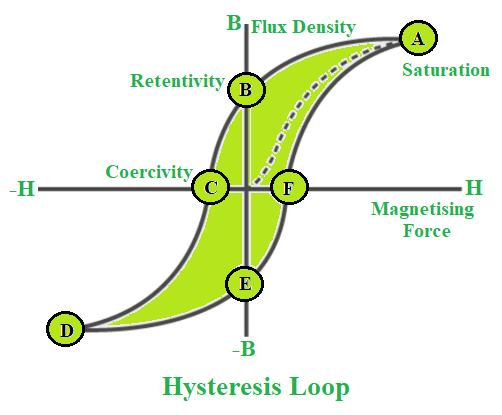磁滞回线 – 定义、能量损失、优势、示例问题
在有磁场的系统中,会出现滞后现象。铁磁材料有一个共同的特性,称为磁滞。磁滞效应是当铁磁材料的磁化滞后于磁场时发生的现象。滞后一词的意思是“滞后”。磁通密度 (B) 滞后于磁场强度,导致磁滞 (H)。
磁滞是所有铁磁材料的特性。让我们看一个将铁磁材料放置在载流线圈内的示例,以更好地理解这个概念。由于存在的磁场,材料会被磁化。滞后现象被称为通过反转电流方向使材料退磁的过程。
磁滞回线
The magnetic flux density and the magnetising field strength are represented by the hysteresis loop. The loop is created by monitoring the magnetic flux emitted by the ferromagnetic material while the external magnetising field is changed.

如果针对各种 H 值测量 B 并且结果以视觉格式呈现,则该图将指示滞后回线。
- 当磁场强度 (H) 从零增加时,磁通密度 (B) 增加。
- 随着磁场的增加,磁性值会上升,直到达到 A 点,该点称为饱和点,B 保持不变。
- 随着磁场值的下降,磁值也会下降。但是,当 B 和 H 都为零时,物质或材料会保留一些磁性,这称为保持性或剩磁。
- 当磁场向负侧减小时,磁性同样会降低。材料在 C 点完全退磁。
- 矫顽力是消除材料保持力 (C) 所需的力。
- 循环以相反方向重复,饱和点 D、保持力点 E 和矫顽力 F。
- 由于正向和反向过程,循环完成,这个循环称为磁滞回线。
磁滞回线的优点
- 滞后的损失表现为滞后回线面积的减小。
- 保持性和矫顽力的相关性由磁滞回线提供给材料。因此,机器的核心使得选择制造永磁体的正确材料变得更加容易。
- BH 图可用于确定剩磁,使电磁体的材料选择变得简单。
保持力和矫顽力
铁磁材料用外磁场磁化后,去除外磁场后,材料不会松弛回到零磁化状态。
保持力——外部磁化场撤去后剩余的磁性量。它是指材料在外磁力撤消后保持一定磁性的能力。磁滞回线点 B 处的磁通密度值就是保持性。
矫顽力 - 物质的矫顽力被定义为使物质完全退磁所需的反向(-ve H)外部磁场的量。磁滞回线点 C 处的 H 值就是矫顽力。
滞后引起的能量损失
- 分析由于滞后引起的能量损失的最大例子是变压器,因为我们知道在整个磁化和退磁过程中都需要能量。
- 磁性物体在磁化和退磁过程中能量膨胀,这种膨胀的能量表现为热。滞后损失是这种类型的热损失的术语。
- 由于变压器中磁化和退磁的连续过程,能量不断以热量的形式损失,降低了变压器的效率。
- 软铁芯用于变压器以防止能量损失,因为软铁中的能量损失或磁滞损失明显低于其他材料。
软磁铁和硬磁铁的区别
- 与硬磁体相比,软磁体容易磁化和退磁。
- 软磁铁的保持力高于硬磁铁。
- 硬磁体的矫顽力高于软磁体。
- 由于表面积很小,软磁体比硬磁体损失的能量更少。
- 在软磁铁的情况下,环路面积小于硬磁铁。
- 软磁铁比硬磁铁具有更高的磁导率。
- 在软磁体中,I 和 χ 都很高,但在硬磁体中,它们都很低。
- 软磁铁是临时磁铁,而硬磁铁是永久磁铁。
- 铁镍合金、铁氧体等是软磁铁的例子,而碳钢、钢、钨、铬钢等是硬磁铁的例子。
磁化和退磁
The method of developing magnetic properties inside a magnetic substance is known as magnetization. With the aid of an electric current or a powerful magnet, any magnetic material may be magnetised.
- 简单来说,如果将任何磁性物质置于外部磁化场中,材料就会被磁化,如果外部磁化场反转,材料就会退磁。
- 当将铁磁材料放入载流线圈时,电流产生的磁化场 H 推动材料的部分或全部原子磁偶极子与外部磁化场对齐,从而使材料磁化。
示例问题
问题1:哪些材料的磁滞回线最窄?
解决方案:
A minimal quantity of wasted energy is implied by a narrow hysteresis loop. This happens because of its limited surface area, which leads to more frequent reversals of applied magnetising force. These narrow hysteresis forms are seen in soft magnetic materials utilised in systems that need alternating magnetic fields.
问题2:变压器铁芯材料的磁滞周期是多少?
解决方案:
The core of the transformer is made of soft iron, which has a low coercivity and a high retentivity. As a result, its hysteresis loop is tall and thin.
问题3:什么是磁滞损耗?
解决方案:
When a transformer core is exposed to alternating magnetising force, hysteresis loss occurs owing to the reversal of magnetization. When the core is exposed to an alternating magnetic field, the material’s domains shift orientation every half cycle. Hysteresis loss is the amount of energy used by magnetic domains to change their orientation every half cycle.
问题 4:选择变压器铁芯的理想特性是什么?
解决方案:
Desired properties for selection of cores are:
- Materials must go through complete magnetisation cycles on a regular basis.
- Low hysteresis loss reduces energy loss.
- To produce a high flux density, high permeability (or susceptibility) is required.
- Eddy-current losses are reduced by having a high resistivity.
- Soft iron, permalloys, and other materials are examples.
问题 5:磁铁的矫顽力为 1 × 10 3 A ⁄ m。应该通过长度为 5 厘米、匝数为 100 的螺线管提供多少电流,以使放入其中的磁铁退磁?
解决方案:
Given:
Length of solenoid, L = 5 cm = 0.05 m
Number of turns, N = 100
So, number of turns per unit length, n = N ⁄ L
= 100 ⁄ 0.05
= 2000
Current to be passed, i = H ⁄ n
= 1 × 103 ⁄ 2000
= 0.5 A
Hence, the current delivered through a solenoid is 0.5 A.